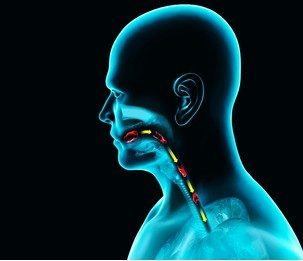#CureSMA2021 – Spinraza Leads to Better Swallowing, Farther Walking
Written by |

Shutterstock/Naeblys
Children with spinal muscular atrophy (SMA) who started taking Spinraza (nusinsersen) before symptoms appeared retained their ability to swallow after approximately four years, while youngsters with later-onset SMA walked farther with less fatigue.
These results, from analyses performed on multiple ongoing clinical trials, were presented by Biogen, Spinraza’s developer, at the 2021 Virtual SMA Research & Clinical Care Meeting, held online June 9-11.
The findings support the continued investigation of a higher dose treatment of the approved therapy, according to Biogen.
“Intervention with Spinraza can meaningfully impact the trajectory of SMA, and we remain relentless in our aim of improving outcomes for people with SMA,” Alfred Sandrock, Jr., MD, PhD, head of research and development at Biogen, said in a press release.
“The data we are presenting at Cure SMA 2021 demonstrate the long-term benefits with Spinraza as individuals age,” Sandrock said.
“Additionally, a new analysis provides further support for the potential for a higher dose of Spinraza to offer even greater improvements in motor function for SMA patients,” he said.
An analysis of two past studies — the Phase 2 CS3A study (NCT01839656) and the Phase 3 ENDEAR study (NCT02193074), both in people with infantile-onset SMA — suggested that a higher dose of Spinraza may lead to meaningful improvements in motor function beyond those seen at the approved 12 mg dose, as measured by the CHOP-INTEND scale.
The result of that analysis supports the rationale for the ongoing Phase 2/3 DEVOTE study (NCT04089566), which is evaluating the safety and efficacy of a higher dose — 28 mg — of Spinraza in people of all ages with SMA.
This three-part study is testing high-dose Spinraza’s safety in Part A, which is open-label, and its efficacy in Part B, which is randomized, controlled, and double-blinded. Part C, which also is open-label, will test the safety and efficacy of transitioning patients already on Spinraza to the higher dose. Of note, open-label means both researchers and participants know what therapies the patients are receiving. In the randomized part, patients are selected at random to receive either Spinraza or a placebo, and neither the researchers nor the participants know who is receiving which one.
Enrollment into Part B is currently open. Participants in this arm of the trial will receive two 50 mg loading doses 14 days apart, followed by 28 mg maintenance doses at approximately one, two, and six months.
An additional analysis from the ongoing Phase 2 NURTURE study (NCT02386553) showed that 23 of its 25 participants (92%) — who began treatment as pre-symptomatic infants — held on to their ability to swallow after a median span of 3.8 years.
This trial is evaluating the safety and effectiveness of Spinraza, given intrathecally, or via the spinal canal, every four months, in 25 presymptomatic newborns genetically diagnosed with SMA, and likely to develop type 1 or 2 disease.
Swallowing typically becomes impaired in patients with two to three copies of the SMN2 gene. That leads to tube feeding and raises a patient’s risk of aspiration pneumonia, choking, and failure to thrive.
Caregivers of children participating in the NURTURE study consistently reported that their children never to rarely experienced difficulty with drinking liquids, eating solid foods, or with feeding in general.
Importantly, all of the children with three SMN2 copies, and 11 of the 15 (73%) with 2 SMN2 copies were reported by their caregivers as being fed exclusively by mouth.
Earlier results from this study had indicated that Spinraza effectively stops SMA progression if it’s started before symptoms appear. In fact, a majority of those treated were able to breathe unassisted and to walk with assistance at an average age of 4 years.
Finally, an analysis performed using data from the completed Phase 1/2 CS2/12 trial (NCT01703988) and the ongoing Phase 3 SHINE study (NCT02594124) indicated that children and teens with later-onset SMA improved their walking distance and showed stabilization in fatigue over five years of treatment.
These data, said Biogen, are consistent with previously reported findings, and support the therapy’s effectiveness.
“We continue to better understand and explore Spinraza’s potential with our new and ongoing global clinical studies,” Sandrock said.






